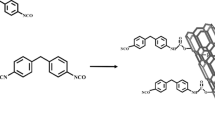Abstract
Carbon nanotubes (CNTs) were added into the self-healing polyurethane materials as conductive filler, the mass fraction of carbon nanotubes was adjusted, and 1% polyaniline was doped. The conductive self-healing polyurethane composites with different carbon nanotubes content (PU)-1/3/5/8/10 were prepared, and analyzed and tested. The result shows that the permeability threshold value of the composite material is 8wt%, and the comprehensive performance of the composite material PU-8 is the best; the resistance of PU-8 is 1278Ω, PU-8P has a resistance of 1400Ω; using an infrared camera, it can be seen that the material can reach 143.3 °C under the DC current of 0.1A, reaching the temperature condition when the material is repaired; the swelling test shows that the PU-8P equilibrium swelling rate is 177%, the gel content is 52.67%, and there is no dissolution in dimethyl sulfoxide. Solvent stability is better than PU-8;DSC test shows that the glass transition temperature of the soft segment of PU-8P is 43 °C, and the glass transition temperature of the hard segment is − 55 °C, which is not much different from that of PU-8; TG test shows that the epitaxial starting temperature of PU-8P is 365 °C; the observation photo is magnified by a stereo microscope at ten times and the PU-8P sample is cut of in the middle at room temperature, applying a constant voltage of 30 V, the cracks disappeared. The material cracks realized self-healing with electricity, and the repair efficiency reached 20.5%.
















Similar content being viewed by others
References
Rule JD, Sottos NR, White SR (2007) Effect of microcapsule size on the performance of self-healing polymers. Polymer 48(12):3520–3529
Mauldin TC, Kessler MR (2010) Self-healing polymers and composites. Int Mater Rev 55(6):317–346
Toohey KS, Sottos NR, Lewis JA, Moore JS et al (2007) Self-healing materials with microvascular networks. Nat Mater 6(8):581
Jackson AW, Fulton DA (2013) Making polymeric nanoparticles stimuli-responsive with dynamic covalent bonds. Polym Chem 4(1):31–45
Zhang XY, Park WX (2019) Research progress of dynamic covalent chemistry. Sci Technol Innov 19:39–41
Xing JJ, Liu L, Qian JH, Zhang YP (2009) Progress in synthesis and application of N-(substituent) maleimide. Chem Reag 31(5):352–354 (392)
Liu YL, Chen YW (2007) Thermally reversible cross-linked polyamides with high toughness and self-repairing ability from maleimide- and furan-functionalized aromatic polyamides. Macromol Chem Phys 208(2):224–232
Feng LB, Yu ZY, Bian YH, Lu JS et al (2017) Self-healing behavior of polyurethanes based on dual actions of thermo-reversible Diels-Alder reaction and thermal movement of molecular chains. Polymer 124:48–59
Cordes EH, Jencks WP (1963)The mechanism of hydrolysis of schiff bases derived from aliphatic amines. J Am Chem Soc
Bai YP (2017) Synthesis and self-healing properties of crosslinked polyurethane based on acylhydrazone bond and disulfide bond [D]. Qingdao University of Science and Technology, QingDao
Cheng CJ, Li J, Yang FH, Li YP (2018) et al. Renewable eugenol-based functional polymers with self-healing and high temperature resistance properties. J Polym Res 25(2)
Zhang YL, Yang B, Xu LX, Zhang XY et al (2013) Self-healing hydrogels based on dynamic chemistry and their application prospects in biomedical materials. Acta Chim Sin 71(4):485–492
Yang YL, Zhang JY, Liu ZZ, Lin QN et al (2016) Tissue-integratable and biocompatible photogelation by the imine crosslinking reaction. Adv Mater 28(14):2724–2730
Wang ZH, Xie C, Yu CJ, Fei GX, Wang ZH, Xia HS (2018) A facile strategy for self-healing polyurethanes containing multiple metal-ligand bonds. Macromol Rapid Commun 39(6):1–7
Yao CD, Xu LB, Wei YP et al (2018) Preparation of highly conductive polyimide/graphene composites by ball milling. Eng Plast Appl 46(1):22–26
Nirmalraj PN, Lyons PE, De S, Coleman JN et al (2009) Electrical connectivity in single-walled carbon nanotube networks. Nano Lett 9(11):3890–3895
Kumar A, Sharma K, Dixit AR (2021) A review on the mechanical properties of polymer composites reinforced by carbon nanotubes and graphene. Carbon Letters 31(2):149–165
Zhang YH, Park SJ (2018) Effect of mercapto-t erminated silane treatment on rheological and mechanical properties of rice bran carbon-reinforced nitrile butadiene rubber composites. Macromol Res 26(5):446–453
Orellana J, Moreno-Villoslada I, Bose RK et al (2021) Self-healing polymer nanocomposite materials by joule effect. Polymers 13(4):649
Willocq B, Bose RK, Khelifa F, Garcia SJ et al (2016) Healing by the Joule effect of electrically conductive poly(ester-urethane)-carbon nanotube nanocomposites. J Mater Chem A 4(11):4089–4097
Xu ZZ, Zhao P, Chen YM, Deng GH (2013) Dynamic polymers containing one acylhydrazone linkage and dynamic behavior thereof. Polymer 54(11):2647–2651
Gao YF, Ying J, Xu X et al (2019) Preparation and electrochemical properties of carbonized products of polyaniline doped with different acids. J Chem Eng Chin Univ 33(1):193–198
Wei YY, Du XC, Ma XY et al (2017) Synthesis and self-healing property of polyurethane modified with three-furyl diol. Polym Bull 74(9):3907–3922
Author information
Authors and Affiliations
Corresponding author
Additional information
Publisher's Note
Springer Nature remains neutral with regard to jurisdictional claims in published maps and institutional affiliations.
Rights and permissions
About this article
Cite this article
Xu, Q., Liu, Y., Chen, Y. et al. Preparation and properties of Joule thermal effect self-healing polyurethane. Carbon Lett. 32, 217–228 (2022). https://doi.org/10.1007/s42823-021-00269-8
Received:
Revised:
Accepted:
Published:
Issue Date:
DOI: https://doi.org/10.1007/s42823-021-00269-8




